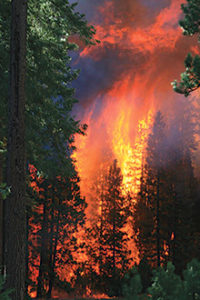The last decade has brought new emphasis to the subject of forest wildfires. Today wildfire issues dominate the efforts and focus of the Forest Service as well as everyone who lives in the vicinity of the forests. But even before the first humans came to North America, fire was shaping the environment.
On Fire! is a play that explores the gritty heroics, the tragedies, and the triumphs of America’s wildland fire fighters. It also portrays the equally dramatic battles in the corridors of power — the wars that would come to determine how America’s wildlands will be managed. Playwright Rick Foster and the actors of the Duende Darma Group joined forces with the Forest Service, the Fire Safe Council, and 3FIA to present this timely drama to the public. On Fire! toured schools, camp grounds, and amphitheaters in the Stanislaus, Sequoia, and Sierra National Forest areas.
Forests and their inhabitants evolved hand in hand with fire. Some species came to depend on fire to complete their life cycles. Native Americans over the centuries, learned to manage their habitat with fire. In California fire was used to beautify the homeland, promote plant species needed for culture, improve hunting grounds, and in other well managed ways.
When Europeans came they used fire to clear land for agriculture and grazing. Settlers, and then railroads, brought countless new fire-starters to the land. Fire deforested vast tracts. Unmitigated clear-cutting wiped out stands of valuable trees and left the land to be invaded by thick brush and trees of no commercial value.
By 1900 the public had become aware of the need to conserve America’s forests. The practice of giving away land, or selling it cheaply to exploiters, came under criticism. The Conservation movement was born, not simply to preserve wilderness but to manage the wild land resources for sustainable yield.
 Conservation got its pPresident in Theodore Roosevelt who in 1905 began to transfer hundreds of millions of acres out of the Department of the Interior and into the new Department of Agriculture’s new Forest Service. This led to an inter-agency war between the Conservationists and the money interests that feared the loss of many a quick fortune.
Conservation got its pPresident in Theodore Roosevelt who in 1905 began to transfer hundreds of millions of acres out of the Department of the Interior and into the new Department of Agriculture’s new Forest Service. This led to an inter-agency war between the Conservationists and the money interests that feared the loss of many a quick fortune.
Fire became the battleground in this war of bureaucrats. Nature set the scene. A dry summer in the Northern Rockies led to catastrophic fires in August of 1910. Smoke from Idaho and Montana darkened the skies of East Coast cities, more than eighty people died. The Army was called in to help. Forest fires became front page news. Even as the war between the bureaucrats heated up the Forest emphasized that it alone could coordinate the fighting of forest fires on a national level. This led it to essentially declare war on all fire, and to adopt a policy of fire exclusion. This well-intentioned crusade had two fatal flaws, though they took two decades to become fully evident.
The first flaw lay in the fact that many species require woodland fire in order to propagate. For example, by the 1980s it was noted that in mature Sequoia groves there were no young sequoia. The under-story was taken over by other species. Only after careful prescribed burning did a new generation of baby giants spring up.
The second flaw was the inability of many forests to deal with th buildup of fuel without the appearance of periodic fires. Now, after decades of fire suppression, drought, and climate change, we have millions of acres waiting to explode in firestorms when the right weather conditions hit.
About 40 years ago federal agencies began to experiment with ways of letting – or helping – fire return to its natural role in the forests. There have been many roadblocks and setbacks. For a host of reasons it has not been possible to reduce the fuel loads to a point where experts feel that catastrophic fires will not continue to occur in force every summer.
Prescribed burning has its own problems. It creates air pollution and changing weather conditions can cause it to leap out of control. Mechanical thinning is extremely labor intensive and is currently considered prohibitively expensive except around valuable assets.
However it is done, an immense effort will be required to bring our forests into a condition of sustainable safety and health. A change of public consciousness will be required, similar to the change that brought the Conservation movement to a position of influence a century ago. By considering the history that brought us to this point, an informed public can better recognize the magnitude of the problem and develop a consensus as to how to best manage our forest for the future. 3FIA’s partnerships to develop and sponsor interpretive presentations that inform and entertain are a part of that endeavor.


